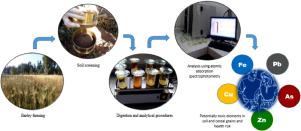Chemical Data Collections Pub Date : 2021-01-12 , DOI: 10.1016/j.cdc.2021.100650 María Custodio , Richard Peñaloza , Walter Cuadrado , Salomé Ochoa , Daniel Álvarez , Fernán Chanamé

|
This article contains data on the concentration of essential and toxic metals in soils and grains of corn and barley from agricultural areas in the province of Concepción in the Mantaro River Valley, Peru. Analytical determinations of Cu, Fe, Pb, Zn and As were performed by flame atomic absorption spectrophotometry. In corn crop soils, the highest mean concentration of Fe (29,733.72 mg kg−1) was recorded in SC4, Zn (1164.89 mg kg‒1) in SC3, Pb (96.49 mg kg‒1) in SC2, Cu (70.80 mg kg‒1) in SC3 y As (12.66 mg kg‒1) in SC1. In barley soils, the highest mean concentration of Fe (29,400.36 mg kg‒1) was recorded in SB1, Zn (1414.06 mg kg‒1) in SB1, Pb (185.31 mg kg‒1) in SB3, Cu (78.48 mg kg‒1) and As (9.36 mg kg‒1) in SB1. The decreasing order of the highest mean concentration of essential and toxic metals in corn and barley grains was: Fe (207.31 mg kg‒1 in corn and 72.97 mg kg‒1 in barley) > Zinc (45.22 mg g‒1 in corn and 65.58 mg kg‒1 in barley) > Cu (2.21 mg kg‒1 in corn and 19.97 mg kg‒1 in barley) > As (0.100 mg kg‒1 in corn and 0.142 mg kg‒1 in barley). The cluster analysis identified two significantly different groups characterized by the concentrations of heavy metals and arsenic in cultivation soil and cereal grains. The HQ values of Pb and As in corn and barley soils indicated that adverse health effects are unlikely (HQing/derm/inh < 1). Soil HI values of both crops were lower than the permitted value (HI < 1). These data can be reused as a basis for estimating cancer risk from exposure to heavy metals and arsenic in soil and grain of corn and barley or as a comparison group for future risk studies.
中文翻译:

原子吸收分光光度法检测土壤,玉米和大麦籽粒中必需和有毒金属的数据及其对人体健康的影响
本文包含有关秘鲁曼塔罗河谷Concepción省农业区的玉米和大麦土壤和谷物中必需和有毒金属浓度的数据。铜,铁,铅,锌和砷的分析测定采用火焰原子吸收分光光度法。在玉米作物的土壤中,Fe的最高平均浓度(29,733.72毫克千克-1)被记录了SC4,锌(1164.89毫克千克-1)在SC3,铅(96.49毫克千克-1)在SC2,铜(70.80毫克公斤-1)在SC3Ý作为(12.66毫克千克-1)的SC1。在大麦土壤中,铁的最高平均浓度(29,400.36 mg kg ‒1)记录在SB1,锌(1414.06 mg kg ‒1)中),SB3中的Pb(185.31 mg kg ‒1),SB1中的Cu(78.48 mg kg ‒1)和As(9.36 mg kg ‒1)。玉米和大麦籽粒中必需金属和有毒金属的最高平均浓度的降序为:铁(玉米207.31 mg kg ‒1和大麦72.97 mg kg ‒1)>锌(玉米45.22 mg g ‒1和65.58大麦mg kg ‒1)>铜(玉米2.21 mg kg ‒1和大麦19.97 mg kg ‒1)> As(玉米0.100 mg kg ‒1和0.142 mg kg ‒1在大麦中)。聚类分析确定了两个明显不同的组,其特征在于耕作土壤和谷物中重金属和砷的浓度。玉米和大麦土壤中铅和砷的HQ值表明不太可能对健康造成不利影响(HQ ing / derm / inh <1)。两种作物的土壤HI值均低于允许值(HI <1)。这些数据可以重新用作估计因暴露于玉米和大麦的土壤和谷物中的重金属和砷所致癌症风险的基础,或作为未来风险研究的比较组。











































 京公网安备 11010802027423号
京公网安备 11010802027423号